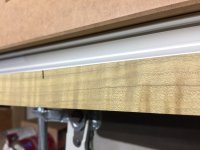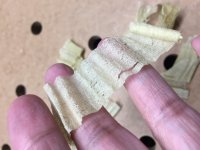How do you typically deal with edge planing or jointing stock where the grain changes direction? I've run into this a few times and the expected result is tear out. In both cases I was using a block plane with a combined 37 degree angle and set to a shallow cut. I'm thinking the solution is to be more careful when selecting stock. In other words, avoid boards where the grain changes direction. Is there anything else I can do to minimize or eliminate that tear out? Going at the board from both sides in the direction of the grain might be possible if it only changes direction once, but I would have to keep flipping the board taking one pass pass on each side, which could be quite a pain if I need to remove a substantial amount of material.
You are using an out of date browser. It may not display this or other websites correctly.
You should upgrade or use an alternative browser.
You should upgrade or use an alternative browser.
Techniques for edge planing stock with changing grain direction?
- Thread starter RKA
- Start date
Brian Puccio
Member
- Joined
- Feb 14, 2018
- Messages
- 10
I’m a handplane novice, so there might be better ways to handle this, but when I was trying to plane Birdseye maple, all the grain changes meant tearout no matter what I did. I was using the Veritas low angle jack, so the combined angle was 37 (25 on the blade, 12 on the bed). I read that as much as low angle planes are the in thing, that’s one of the downsides, easy to have tearout. At the risk of spending more money and getting nowhere (can’t buy yourself out of lack of skill), I picked up the 50 degree blade (combined 62 degrees now) and set it to take as thin as possible a shaving. No tearout.
It’s possible that your angle is just too low?
It’s possible that your angle is just too low?
derekcohen
Member
- Joined
- Jun 22, 2008
- Messages
- 940
Brian is correct. If you are using a BU plane, then you will want a high cutting angle, somewhere around 60 degrees (or a little more). The alternative, even better, is a BD plane (with a common angle, or 45 degree bed) with a close set chipbreaker.
Regards from Perth
Derek
Regards from Perth
Derek
PaulMarcel
Member
Same as Brian and Derek... I have a plane with a 55º attack angle I use for squirrelly grain and it comes out so nice. Bit of a workout if you don't need that angle, tho.
While you're talking about edge planing, I'll mention that a toothed blade is fantastic for face planing or leveling high spots before running through a helical planer. Much easier to push than a high-angle blade when going for bulk without the tearout.
While you're talking about edge planing, I'll mention that a toothed blade is fantastic for face planing or leveling high spots before running through a helical planer. Much easier to push than a high-angle blade when going for bulk without the tearout.
Well that was surprisingly easy! After I got the jack plane dialed in with the chip breaker set as close as I could, I grabbed a piece of stock that previously gave me trouble and took a series of passes against the grain the entire length...no tearout!  . What a thing of beauty! Thank you!!
. What a thing of beauty! Thank you!!
Regarding the toothed blade, it seems like those are only available for a low angle jack on LN’s website. Nothing available for the bevel down planes, but it looks like it was available at one time. Any idea why?
Regarding the toothed blade, it seems like those are only available for a low angle jack on LN’s website. Nothing available for the bevel down planes, but it looks like it was available at one time. Any idea why?
PaulMarcel
Member
The BD plane likely has a 45º bed (vs 37º) so you're using a higher angle, which should help especially after tuning.
I have no idea why BD planes don't have toothed blades available. I mostly don't have any BDs.
I have no idea why BD planes don't have toothed blades available. I mostly don't have any BDs.
demographic
Member
- Joined
- May 9, 2015
- Messages
- 795
One handy thing about having a few Bailey pattern handplanes is that you can pick up a few spare blades from Ebay or fleamarkets pretty cheaply.
You can enter into a whole new world of backbevels on BD handplanes without breaking the bank.
I've yet to have a bash at making a toothed blade but it cant be rocket science can it?
Cheap blade
You can enter into a whole new world of backbevels on BD handplanes without breaking the bank.
I've yet to have a bash at making a toothed blade but it cant be rocket science can it?
Cheap blade
So I did a little more testing setting the chip breaker as close as 1/64” from the edge of the iron as suggested in a lot of places. I used a magnifier the check it and ensure I wasn’t going too far. I found the plane was difficult to push and the shavings were very crinkled and somewhat thick for a smoothing pass (0.002-0.004”). It didn’t feel right. Moving the blade in and out didn’t seem to help, it either didn’t cut or gave me the results I describe.
Then after 2 hours of researching to understand what was happening I found one illuminating post that indicates the distance is variable depending on the wood, grain and probably other factors, but you just have to try a few settings from 1/16-1/64” to see what works best.
So I backed off the chip breaker to 1/32”, adjusted the blade feed screw for a whispy smoothing shave and tried again on a scrap of poplar with grain running in both directions. Like magic, the plane glided over the surface and produced translucent shavings 0.001” thick. This looks like the sweet spot.
I’m loving the experience with a bevel down plane! I did read a little about back bevels, but I have a question. If you’re setting the chip breaker up tight to the iron, wouldn’t a back bevel create a little wedge for shavings to lodge or is the chipbreaker set behind the trailing edge of the back bevel (so not tight to the blade edge)?
Then after 2 hours of researching to understand what was happening I found one illuminating post that indicates the distance is variable depending on the wood, grain and probably other factors, but you just have to try a few settings from 1/16-1/64” to see what works best.
So I backed off the chip breaker to 1/32”, adjusted the blade feed screw for a whispy smoothing shave and tried again on a scrap of poplar with grain running in both directions. Like magic, the plane glided over the surface and produced translucent shavings 0.001” thick. This looks like the sweet spot.
I’m loving the experience with a bevel down plane! I did read a little about back bevels, but I have a question. If you’re setting the chip breaker up tight to the iron, wouldn’t a back bevel create a little wedge for shavings to lodge or is the chipbreaker set behind the trailing edge of the back bevel (so not tight to the blade edge)?
Attachments
demographic
Member
- Joined
- May 9, 2015
- Messages
- 795
Another thing worth trying is a scraper.
Even just a card scraper can produce surprisingly good results on wild grain.
I've yet to do the toothed plane blade followed by a card scraper method but I'm wanting a toothed blade to give it a try.
Even just a card scraper can produce surprisingly good results on wild grain.
I've yet to do the toothed plane blade followed by a card scraper method but I'm wanting a toothed blade to give it a try.
derekcohen
Member
- Joined
- Jun 22, 2008
- Messages
- 940
demographic said:Another thing worth trying is a scraper.
Even just a card scraper can produce surprisingly good results on wild grain.
I've yet to do the toothed plane blade followed by a card scraper method but I'm wanting a toothed blade to give it a try.
That may work for face grain, but edges?! [wink] Edges need to be flat and square. Scraping is likely to damage that. I would stick to a jointer with either a high cutting angle (BU) or a closed chipbreaker (BD).
Regards from Perth
Derek
demographic
Member
- Joined
- May 9, 2015
- Messages
- 795
Yeah, I got carried away by the thought of general wild grain and forgot about it being on edges.
My bad.
My bad.
Similar threads
- Replies
- 0
- Views
- 168
- Replies
- 6
- Views
- 629
- Replies
- 32
- Views
- 3K
- Replies
- 60
- Views
- 5K


